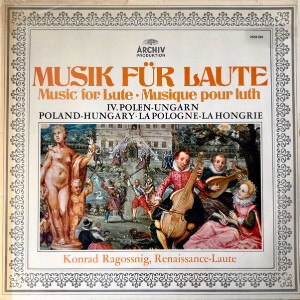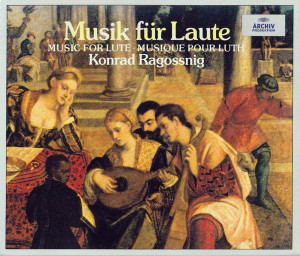 |
|
1 LP -
2533 294 - (p) 1975
|
 |
| 4 CD's -
447 727-2 - (c) 1995 |
|
| MUSIK FÜR LAUTE |
|
|
|
|
|
|
|
Lute Music of the Renaissance
- IV. Polen/Ungarn - Poland/Hungary -
La Pologne/La Hongrie
|
|
|
|
|
|
|
|
| Diomedes Cato
(ca.1570-ca.1602) |
Praeludium |
Piotr Pozniak,
Preludia, fantazje, tance
imadrygali Polskjie Wydawnictwo
Myzyczne = PWM, Warszawa 1970 |
|
0' 49" |
A1 |
|
Galliarda I |
Piotr Pozniak,
Preludia, fantazje, tance
imadrygali Polskjie Wydawnictwo
Myzyczne = PWM, Warszawa 1970 |
|
1' 38" |
A2 |
|
Galliarda II |
Piotr Pozniak,
Preludia, fantazje, tance
imadrygali Polskjie Wydawnictwo
Myzyczne = PWM, Warszawa 1970 |
|
1' 41" |
A3 |
|
Favorito |
Piotr Pozniak,
Preludia, fantazje, tance
imadrygali Polskjie Wydawnictwo
Myzyczne = PWM, Warszawa 1970 |
|
2' 33" |
A4 |
| Anonym |
Balletto Polacho |
Zofia
Steszewska, Tance
Polskie, PWM, Krakow
1965 |
|
2' 46" |
A5 |
| Jakub Polak (gest.
ca.1605) |
Praeludium |
Maria
Szczepanska, Preludia, fantazje
i tance na lutnie, PWM, Krakow
1951 |
|
1' 24" |
A6 |
| Albert
Dlugoraj (ca.1557 - nach 1619) |
Chorea polonica |
Zofia
Steszewska, Tance
polskie z tabulatur
lutniowych, PWM,
Warszawa 192
|
|
1' 40" |
A7 |
|
Fantasia |
Piotr Pozniak,
Dlogoraj - Fantasje i Wilanele,
PWM, Krakow 1964 |
|
2' 15" |
A8 |
|
Finale |
Piotr Pozniak,
Dlogoraj - Fantasje i Wilanele,
PWM, Krakow 1964 |
|
0' 46" |
A9 |
|
Villanella |
Piotr Pozniak,
Dlogoraj - Fantasje i Wilanele,
PWM, Krakow 1964 |
|
1' 03" |
A10 |
|
Carola Polonesa |
Zofia
Steszewska, Tance
polskie z tabulatur
lutniowych, PWM,
Warszawa 192
|
|
0' 58" |
A11 |
|
Villanella |
Piotr Pozniak,
Dlogoraj - Fantasje i Wilanele,
PWM, Krakow 1964 |
|
2' 47" |
A12 |
|
Finale |
Piotr Pozniak,
Dlogoraj - Fantasje i Wilanele,
PWM, Krakow 1964 |
|
0' 46" |
A13 |
|
Kowaly |
Zofia
Steszewska, Tance
polskie z tabulatur
lutniowych, PWM,
Warszawa 192
|
|
2' 45" |
A14 |
|
Finale |
Piotr Pozniak,
Dlogoraj - Fantasje i Wilanele,
PWM, Krakow 1964 |
|
0' 46" |
A15 |
| Valentin Bakfark
(1507-1576) |
Fantasie |
Otto
Gombosi, Der Lautenist
Valentin Bakfark,
Musicologia Hungarica
I, Bärenreiter, Kassel
1967 |
|
3' 30" |
B1 |
|
Fantasie |
Otto
Gombosi, Der Lautenist
Valentin Bakfark,
Musicologia Hungarica
I, Bärenreiter, Kassel
1967 |
|
8' 41" |
B2 |
|
Fantasie |
Otto
Gombosi, Der Lautenist
Valentin Bakfark,
Musicologia Hungarica
I, Bärenreiter, Kassel
1967 |
|
4' 21" |
B3 |
|
Fantasie |
Otto
Gombosi, Der Lautenist
Valentin Bakfark,
Musicologia Hungarica
I, Bärenreiter, Kassel
1967 |
|
4' 05" |
B4 |
|
|
|
|
Konrad RAGOSSNIG,
Laute
|
| Achtchörige
Renaissance-Laute von David J. Rubio, Duns
Tew/Oxford, 1971 (Kopie nach Martin
Hoffmann, Leipzig, 2.Hälfte des 17.
Jahrhunderts) |
|
|
|
|
Luogo
e data di registrazione |
|
Plenarsaal,
München (Germania) - 28/30 ottobre
1974 |
|
|
Registrazione:
live / studio |
|
studio |
|
|
Executive Producer |
|
Dr.
Andreas Holschneider |
|
|
Recording Producer |
|
Dr.
Gerd Ploebsch |
|
|
Balance Engineer |
|
Heinz
Wildhagen |
|
|
Prima Edizione LP |
|
ARCHIV
- 2533 294 - (1 LP - durata 45'
33") - (p) 1975 - Analogico |
|
|
Prima Edizione CD |
|
ARCHIV
- 447 727-2 - (4 CD's - durata 71'
05"; 73' 47"; 68' 14" & 62'
37" - [CD3 1-19]) - (c) 1995 - ADD
|
|
|
Cover |
|
Frederik
von Valckenborch: Musikantengruppe
(Öil auf Holz) - Germanisches
Nationalmuseum, Nürnberg - Photo:
Scala Florenz
|
|
|
Note |
|
-
|
|
|
|
|
In
the 16th century lutenists
played a privileged role among
court and town musicians (as may
be seen from their high rates of
pay) and they often became
confidants of their patrons and
protectors (as can be seen from
various special grants), for
there was scarcely a situation
that they did not accompany with
their music - even if hidden
behind a curtain! Moreover, they
instructed members of the court
and citizens of the town in the
art of playing the lute and
thereby were best informed about
all opinions, rivalries and
alliances. So it is not to be
wondered at if lutenists were
heavily, if also secretly,
involved in the political scene
and pursued their own plans. But
it was also inevitable that many
a lutenist had to quit his
country if political
constellations changed, and went
in danger of life and limb.
The life histories of the
lutenists represented in this
part of the present recording
were governed by this
amalgamation of political and
musical activity.
Diomedes Cato born in Venice,
was engaged by the treasurer of
the Prussian ruler of Poland, S.
Kostka, at the Polish royal
court, where he must have
rendered such great service to
his lord and patron that the
latter bequeathed to him 10,000
ylotys.
Wojciech (Albert) Dlugoraj was
less fortunate. He repeatedly
attempted to escape from the
service of his master, S.
Zborowski, who however compelled
him to return each time.
Ultimately, because of various
intrigues he had to flee to
Germany.
The Hungarian Valentin
Greff-Bakfark (1507-76) felt
himself more committed to his
patron, Duke Albrecht of
Prussia, than to his employer,
the King of Poland. First of all
lutenist at the Transylvanian
court in Kronstadt, on
Albrecht’s recommendation he
came to the Polish court at
Cracow (1549). He took advantage
of a year of mourning there, in
which no music was required, to
pay a visit to Italy, Germany
and France, from which he sent
political news not to Cracow,
however, but to Königsberg.
Bakfark attained high status at
the Polish court, but
nevertheless maintained his
close association with
Königsberg. At the start of
1566, he had to leave Cracow in
all haste and seek refuge in
Posen (Pozǹan). He instructed
his wife to dispose of all his
belongings in Königsberg, while
his home in Vilna was seized by
soldiers. By way of Vienna
(1566) and Kronstadt (1568) he
came to Padua (1571), where he
and his family later fell
victims to the plague.
Of Jakub Polak we only know that
he gave up his profession in his
native country and was active as
a lutenist at the French court.
Like the output of almost all
lutenists, that of Bakfark and
the other Polish lutenists is
not very extensive, because the
lutenists themselves improvised,
for the most part. In the books
are found versions in tablature
(lute arrangements) of concerted
vocal music, independent pieces
for lute with and without a bass
pattern (Passamezzi, as in
Preludes and Fantasias), and
dances arranged in groups
(Galliards, Allemandes, Choreal.
etc.). National peculiarities
can be detected only in the
dance music ofthe respective
folk music. Even if no simple
definition of a Polish dance can
be found - it is nevertheless
always a question of a
regular-metre step-dance with or
without a following
leaping-dance - the following
features are generally present:
a) at the start or at the
cadences, sharply accentuated
rhythms;
b) full-textured, chordal
phrases, in which often every
note of the melody is harmonized
- from which arises a somewhat
ponderous impression;
c) melodically, a flourish, once
hit upon, was frequently
repeated;
d) the formation of phrases is
not uniform: alongside four-bar
groups are found irregularly
formed six-bar groups, and both
forms can occur side by side
throughout a dance.
|
|
|

